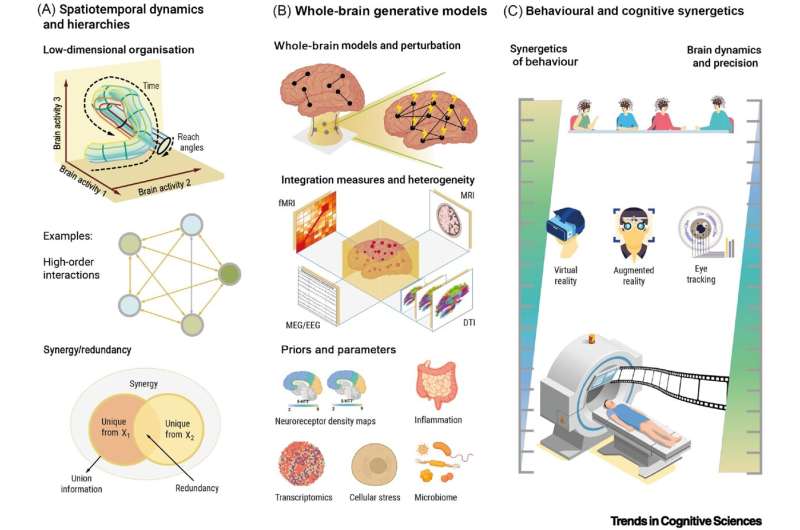This article has been reviewed according to Science X's editorial process and policies. Editors have highlighted the following attributes while ensuring the content's credibility:
fact-checked
peer-reviewed publication
trusted source
proofread
New model for understanding the brain paves the way for more accurate diagnoses and treatments

How does our brain interact with our body, and how is its functioning conditioned by physical and environmental conditions? Despite the significant breakthroughs in neuroscience, these questions remain largely unanswered.
Posed with this challenge, a recent study published in Trends in Cognitive Sciences defines a new neuroscientific paradigm (the synergistic model), which allows researchers to better understand the complexity of the interactions between brain, body and environment, and paves the way to being able to differentiate different levels of brain diseases, make more accurate and personalized diagnoses of various brain diseases, and identify new treatments that are better adjusted to the specific needs of each patient.
As its name suggests, the synergistic framework is characterized by looking for the dynamics of different levels of brain functioning. Their combination gives rise to a new, more accurate and richer framework of analysis for understanding brain dynamics. Among the approaches that the synergistic framework combines, the semi-empirical modeling of biophysical mechanisms is noteworthy.
Brain functioning is considered holistically and the mechanisms of orchestration of different regions are approached based on mathematical and computational models. This model also connects with a naturalistic perspective, which addresses human cognition and behavior, taking into account how they are conditioned by the natural and environmental surroundings.
The principal investigator of the study and co-author of the article is Gustavo Deco (UPF, ICREA), director of the Computational Neuroscience group at the UPF Center for Brain and Cognition (CBC).
As the researchers explain, the new synergistic paradigm helps clarify the complex interactions between the hierarchical structure of the brain and its cognitive functions, about which a great deal is still unknown in the field of neuroscience. In this sense, it can shed light on the specific neural mechanisms that underlie certain cognitive processes.
The new model will enable a better understanding of brain diseases
In the opinion of first author Agustín Ibáñez, "This model allows us to integrate multiple apparently discrepant data into a low-dimensionality model that provides a more relevant understanding for cognitive neuroscience and brain diseases. In turn, it proposes a specific systemic framework to address the current critical challenges of understanding brain diseases."
For Deco, meanwhile, "this new theoretical approach provides very concrete and precise tools such as using dimensionality reduction to understand the self-organization of any complex macroscopic system, such as the brain, which comprises many non-linear interacting subsystems.
"The self-organization of this multiple description of the original complex dynamics depends on external control parameters, including energy flows within the system and the external environment. Another important factor is the thermodynamic analysis that allows conceptualizing and analyzing the hierarchical orchestration of the brain's temporal-spatial dynamics. This will enable a more complete and productive understanding and treatment of brain diseases for the benefit of neurology and psychiatry."
It will be possible better to understand the specific features of each person's brain
Thanks to the synergistic framework, it will be possible to understand better and address the diversity and heterogeneity of the observable brain traits that characterize each person (phenotypes).
This will allow a more complete and accurate view of the causes of brain diseases in each individual patient and will pave the way to designing more personalized therapies and treatments. Another fundamental feature of this new framework of analysis is that it integrates different existing diagnostic models into one (rendering it a transdiagnostic model).
This contributes to overcoming the fragmented research approaches that have prevailed so far in the field of neuroscience and hinder identifying the causes of psychiatric or neurological diseases beyond their symptoms or pathological manifestations. With the new synergistic paradigm, it is possible to determine the mechanisms that underlie each disease and even determine physiopathological mechanisms shared between different psychiatric and neurological disorders.
How environmental factors condition brain activity to be studied more precisely
Finally, the new paradigm includes naturalistic frameworks and analyzes how social and environmental factors condition brain activity. By way of example, the external factors that can influence brain dynamics include pollution levels, the availability or lack of green spaces, the density of urban environments, the level of structural inequality, etc.
Taking these environmental factors into account, the synergistic model contributes to overcoming the lack of current strategies in the field of neuroscience to analyze globally the functioning of the brain, especially to understand the underlying causes of different diseases.
More information: Agustin Ibanez et al, A synergetic turn in cognitive neuroscience of brain diseases, Trends in Cognitive Sciences (2024). DOI: 10.1016/j.tics.2023.12.006





















